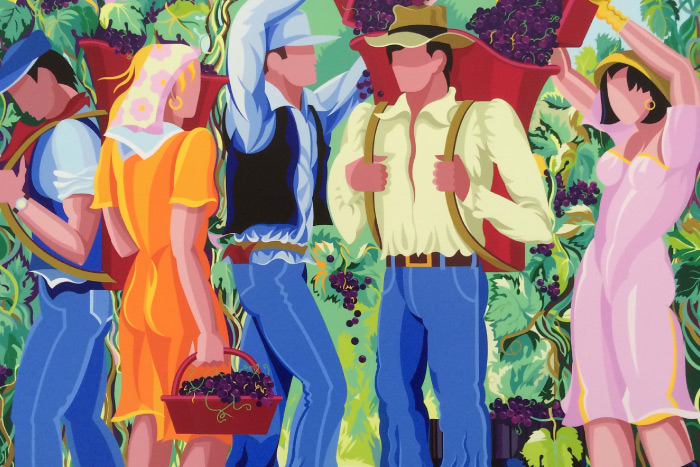Dan's Papers Cover Artist Giancarlo Impiglia Paints the Harvest

For more than 50 years, writes Giancarlo Impiglia in his 2012 publication, Paintings for the Queens & Collected Works, he has been “detaching” himself “from conformity…by embracing a unique vision where eclecticism is the foundation of my signature style.” Detaching, indeed!
Fans familiar with Impiglia’s work of the last few decades—bold-colored, fractal acrylics of dazzling diagonals, intricate interlocking shapes and stylized, sophisticated fantasy urban scenes of faceless figures on the go—will perhaps be surprised by the artist’s relatively new direction. “Harvest,” this week’s cover art, dates back to 1990, and falls into Impiglia’s earlier mode. It’s the perfect image to celebrate Dan’s Harvest East End on August 22 in Cutchogue.
For the last few years, Impiglia has been exploring new subjects, new symbols, historical religious figures set in new contexts. His new works not only show his accomplishments as a fine artist in the Italian classical tradition, but also point to his growing passion to have art say something about the need for peace.

Will viewers no longer see Impiglia, the neo-Cubist, neo-Futurist, neo-Art Deco artist?
A foldout flyer essay, “Giancarlo Impiglia, Sacred and Profane,” accompanying a recent show I had in the city [“For That Which is Sacred” at Gallery Nine 5], written by my son Christopher, discusses my transformations of biblical themes. It also contains a few pictures—“Pride Cast Down,” “The Wound [of Christ].” Also included on that flyer is “Nature’s Fallacy, 2013,” a colorful design done in the geometric angle-and-swirl style of my earlier periods—but note that the abstract figure is set against camouflage, emphasizing the military’s attempt to use, to hide in, nature.
Does your new “camouflage” direction with its referencing and allusions to famous pieces by, among others, Michelangelo Merisi da Caravaggio and Giovanni Bellini, need interpretation?
I am happy to point out how I have transformed certain famous religious works in order to emphasize a message against war and violence. My [oil on panel] “St. Sebastian, 2011,” after Bellini’s “Saint Sebastian,” for example, with arrows into the martyr’s muscular frame, is set against a shiny red surface background, like a Ferrari would have, in order to show the contrast of a classical suffering human being and our world of gold, driven by economic desire that drives war. “Meditation on War” [oil and acrylic on camouflage fabric], rendered in traditional Buddhist colors, shows lotus flowers, symbols of tranquility, floating against a background that’s clearly military.
How would you relate the “camouflage” paintings to this week’s cover art, a seemingly peaceful harvesting of grapes?
Grapes are featured in one of my recent works, “Young Bacchus,” which I have transformed from Bellini’s 1510 painting of sweet innocence. His “Young Bacchus” is a seemingly harmless portrait of the Greek god of debauchery. My transformation has been described as intending to convey the apathy of those content to ignore the tribulations of the world around them. Bacchus represents a disinterested community, noncombatant in its enjoyment of the spoils of war. The words on some of my new paintings, sometimes Latin, sometimes Old Italian, taken from Vatican archives and scriptural sources, as my son’s essay points out, are meant to show “the timeless nature of violence and the brutality of today’s society.” As for this week’s cover, harvest time is when we gather the crops. It’s a good time to reflect on what we have sown, and what we may reap.
To visit Giancarlo Impiglia’s studio in Bridgehampton call 631-613-6139, or see giancarloimpiglia.com. For tickets and more information about Dan’s Harvest East End go to DansTaste.com.




